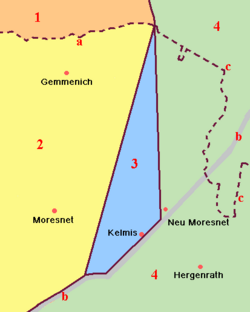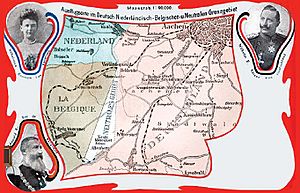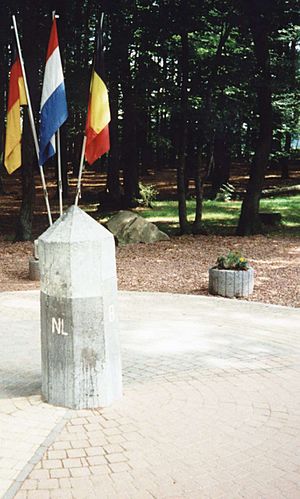Neutral Moresnet facts for kids
Quick facts for kids
Neutral Moresnet
|
|||||||||
|---|---|---|---|---|---|---|---|---|---|
| 1816–1920 | |||||||||
|
Anthem: Hymn Moresnetu
"the Amikejo-March" |
|||||||||

|
|||||||||
| Status | Neutral zone | ||||||||
| Capital | Kelmis | ||||||||
| Languages | |||||||||
| Demonym(s) | Moresnetic | ||||||||
| Government | Condominium sui iuris | ||||||||
| Mayor | |||||||||
|
• 1817–1859 (first)
|
Arnold de Lasaulx | ||||||||
| Historical era | Late modern | ||||||||
|
• Aachen Agreement
|
26 June 1816 | ||||||||
|
• Prussian annexation
|
27 June 1915 | ||||||||
| 28 June 1919 | |||||||||
|
• Belgian annexation
|
10 January 1920 | ||||||||
| Area | |||||||||
|
• Total
|
3.5 km2 (1.4 sq mi) | ||||||||
| Population | |||||||||
|
• 1900
|
3,000 | ||||||||
|
• 1914
|
3,500 | ||||||||
| Currency | French franc | ||||||||
|
|||||||||
| Today part of | Belgium | ||||||||
Neutral Moresnet was a tiny piece of land in western Europe. It existed from 1816 to 1920. This small area was managed jointly by two countries: the United Kingdom of the Netherlands (later Belgium) and Prussia (part of modern-day Germany).
Imagine a very small country, only about 1 mile (1.6 km) wide and 3 miles (4.8 km) long. Its total area was about 900 acres (360 hectares). Its northernmost point, called Vaalserberg, was a special spot where four different areas met. Today, this spot is known as the Three-Country Point, where Belgium, Germany, and the Netherlands meet.
During World War I, Germany took control of Neutral Moresnet. However, other countries did not agree with this. After the war, a peace agreement called the Treaty of Versailles gave Neutral Moresnet to Belgium. This happened on January 10, 1920. The territory then became a Belgian town called Kelmis.
Later, during World War II, Germany again took over Kelmis for a short time. But in 1944, it was returned to Belgium.
Contents
History of Neutral Moresnet
How Neutral Moresnet Started
After Napoleon's empire ended, European leaders met at the Congress of Vienna in 1814–15. They wanted to redraw the map of Europe to create a balance of power. One tricky border was between the new United Kingdom of the Netherlands and Prussia.
Most of the border was easy to agree on. But the area around Moresnet was a problem. This was because of a valuable zinc spar mine called Altenberg (or Vieille Montagne). Both the Netherlands and Prussia wanted this mine. Zinc was important for making zinc and brass.
In 1815, Dutch and Prussian officials met. On June 26, 1816, they reached a deal. They divided the Moresnet area into three parts. The Netherlands got the village of Moresnet. Prussia got another village, which was later called Neu-Moresnet. The mine and the village next to it became a special "neutral territory." This meant it didn't belong fully to either country.
Both powers agreed not to send their armies into this neutral zone. They set up a joint administration to manage it together. When Belgium became independent from the Netherlands in 1830, Belgium took over the Dutch role in Neutral Moresnet.
Neutral Moresnet's Borders
The borders of Neutral Moresnet were officially marked on September 23, 1818. The territory had a shape like a triangle. The bottom of the triangle was the main road from Aachen to Liège. The village and the mine were just north of this road. Two straight lines met at the Vaalserberg to form the top point of the triangle.
Today, the roads leading to the Three-Country Point have interesting names. From Germany, it's called "Dreiländerweg" (Three Countries Way). From Belgium, it's "Route des Trois Bornes" (Three Border Stones Road). And from the Netherlands, it's "Viergrenzenweg" (Four Borders Way).
The Flag of Neutral Moresnet
From 1883, Neutral Moresnet had its own flag. It was a tricolour with horizontal stripes of black, white, and blue. No one is completely sure where these colors came from.
One idea is that the colors were taken from the flags of the two countries that shared control. Black and white might have come from Prussia, and white and blue from the Netherlands.
Another idea, which seems more likely, is that the colors came from the emblem of the Vieille Montagne mining company. This company was very important in Neutral Moresnet.
How Neutral Moresnet Was Governed
Neutral Moresnet was run by two royal commissioners, one from Belgium and one from Prussia. These commissioners were usually government workers from nearby Belgian Verviers and Prussian Eupen. A mayor was chosen by these commissioners to manage the local government.
The laws in Neutral Moresnet were based on the Napoleonic civil and penal codes, which were introduced when the French ruled the area. Since there was no local court, judges from Belgium and Prussia had to come in to decide cases. Also, if the mayor made a decision, there was no way to appeal it.
In 1859, Neutral Moresnet got a bit more self-rule. A town council of ten members was created. The mayor appointed these council members, and they gave advice on local matters. However, the people living there did not have the right to vote.
The Vieille Montagne mining company played a huge role in Neutral Moresnet. It was the main employer and also ran homes, shops, a hospital, and a bank. Many workers from nearby countries moved to Neutral Moresnet to work in the mine. This caused the population to grow from 256 people in 1815 to 4,668 in 1914. Most services, like mail, were shared between Belgium and Prussia. There were five schools, and Prussian children could also go to schools in Prussian Moresnet.
Living in Neutral Moresnet had some good points. Taxes were low, and there were no import tariffs from Belgium or Prussia. Prices for goods were also lower than in neighboring areas. However, there was a downside: people from Neutral Moresnet were considered stateless. This meant they didn't officially belong to any country and weren't allowed to have their own military.
Many people moved to Moresnet to avoid military service in their home countries. But after a while, both Belgium (in 1854) and Prussia (in 1874) started making their citizens who had moved to Moresnet join the military anyway. After that, only the children of the original residents were exempt.
Money in Neutral Moresnet
Neutral Moresnet did not have its own money. The French franc was the official currency. However, money from Prussia (and later Germany), Belgium, and the Netherlands was also used. In 1848, some local coins were made, but they were not considered official money.
An Uncertain Future
By 1885, the zinc mine was running out of ore. This made people wonder what would happen to Neutral Moresnet. Around this time, Dr. Wilhelm Molly, the mine's chief doctor, tried to start a local postal service with its own stamps. But Belgium quickly stopped this plan.
Around 1900, Germany started to be more aggressive about the territory. Germany was accused of causing problems to try and force the area to become part of Germany.
A casino was opened in August 1903. This happened after Belgium closed all casinos in its own country. The Moresnet casino had strict rules: local residents couldn't gamble, and no more than 20 people could be there at once. However, the casino closed when Kaiser Wilhelm II of Germany threatened to divide the territory or give it to Belgium to stop the gambling. Around the same time, Moresnet had three factories that made gin.
In 1908, Dr. Molly had another idea. He suggested making Neutral Moresnet the world's first state where everyone spoke Esperanto. He wanted to call it Amikejo, which means "friendship-place." The proposed national anthem was an Esperanto song with the same name. Many residents learned Esperanto, and a meeting was held in Kelmis on August 13, 1908, to support the idea. The World Congress of Esperanto even declared Neutral Moresnet the world capital of the Esperanto community.
Neutral Moresnet During World War I
World War I brought an end to Neutral Moresnet's special status. On August 4, 1914, Germany invaded Belgium. At first, Neutral Moresnet was left alone, like a peaceful spot in a war zone. However, 147 citizens of Neutral Moresnet died during the war. It's not clear if they died inside the territory or fighting outside its borders. On June 27, 1915, Germany officially took over Neutral Moresnet, but other countries didn't recognize this.
In 1918, the war ended with an agreement between France and Germany. This forced Germany to leave Belgium and also Neutral Moresnet. The German mayor, Wilhelm Kyll, who had been appointed after the German invasion, was removed from office.
On June 28, 1919, the Treaty of Versailles finally settled the issue of Neutral Moresnet. The treaty gave Neutral Moresnet, along with other German areas like Eupen and Malmedy, to Belgium. This became official on January 10, 1920. This day marked the end of Neutral Moresnet's existence. The territory became a new municipality in Belgium.
To tell it apart from an existing town called Moresnet, the former Neutral Moresnet was renamed Kelmis. This name comes from kelme, the local word for zinc spar.
Even after the annexation, Neutral Moresnet's last mayor, Pierre Grignard, stayed in charge and became the first mayor of Kelmis. The ten members of Neutral Moresnet's old council also became part of the new Kelmis town council. They stayed in office until new elections were held in 1923.
After Neutral Moresnet Ended
After 1920, Kelmis became part of the German-speaking community of Belgium. Germany briefly took over the area again during World War II, but it was returned to Belgium in 1944. In 1977, Kelmis grew bigger by joining with the nearby towns of Neu-Moresnet and Hergenrath.
Today, there's a small museum in Kelmis called the Museum Vieille Montagne. It has exhibits about Neutral Moresnet. Many of the original 60 border markers that showed the territory's boundaries are still standing today.
The Vieille Montagne mining company, which was so important to Neutral Moresnet, still exists today. It's now called VMZINC and is part of a larger company called Umicore.
The last known citizen of Neutral Moresnet, Catharina Meessen, passed away in early 2020 at the age of 105.
List of Mayors
- Arnold Timothée de Lasaulx, the first mayor, served from 1817 to 1859.
- Pierre Grignard, the last mayor, served from 1918 to 1920.
See also
 In Spanish: Moresnet para niños
In Spanish: Moresnet para niños
- Interhelpo
- Couto Misto







